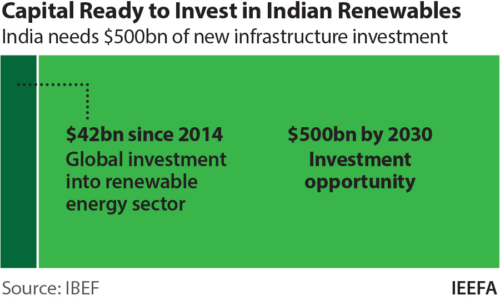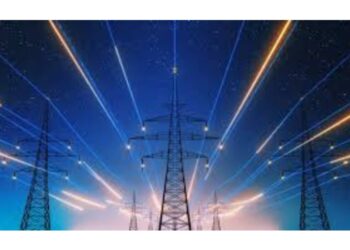A huge global capital pool is mobilising to invest in renewable energy and grid projects in India, according to a new IEEFA report, with pull factors including solar power tariffs hitting record lows, plunging solar module costs, record low interest rates, and the security of government-backed, 25-year power purchase agreements (PPAs).
“Domestic and global institutions across the financial, corporate, energy, utility and government sectors are primed to deploy a wall of capital that India needs to fund its ambitious renewable energy targets,” says report co-author Tim Buckley, Director Energy Finance Studies, South Asia, at the Institute for Energy Economics and Financial Analysis (IEEFA).

While the renewable energy sector in India has received more than $US42 billion in investment since 2014, the report highlights that it will require a further US$500 billion in order to reach 450 gigawatts (GW) of capacity by 2030.
This includes the capital cost of adding more than 300GW of new renewables infrastructure, firming low-cost but intermittent renewable power generation, and expanding and modernising grid transmission and distribution.
The report – co-written by IEEFA research analyst Saurabh Trivedi – comes as the International Energy Agency’s new India Energy Outlook 2021 says India will need $1.4 trillion in additional funding for low emissions technologies in order to be on a sustainable path over the next 20 years – 70% higher than in a scenario based on current policy.
“India has a once-in-a-generation opportunity to transform its energy system, and the benefits of doing so are huge,” says Buckley.
“India could dramatically improve its energy security by reducing reliance on expensive fossil fuel imports. The ongoing solar energy deflation – now around Rs.2/kWh, below the marginal fuel cost of coal-fired power plants – gives India the economic incentive to accelerate its energy transition and be a world leader in helping to solve the climate crisis, plus address chronic air pollution and water stress.
“Our report focuses on the enormous amount of capacity building that has been undertaken in 2020 such that global capital is ready, willing and able to be deployed at an unprecedented scale in building domestic, zero-emissions, low-cost renewable infrastructure in India.
“We estimate that striving for 450 gigawatts of renewable energy by 2030 would require deploying $500 billion of investment over the coming decade – $300 billion for wind and solar infrastructure, $50 billion on grid firming investments such as gas peakers, hydro and batteries, and $150 billion on expanding and modernising transmission and distribution.”
IEEFA’s new report identifies the capital flowing into the renewables sector for new projects and infrastructure investment trust (InvIT) structures, as well as the capital recycling opportunities for the National Investment and Infrastructure Fund (NIIF) for operational projects.
The sources of capital range from private equity, global pensions funds and sovereign wealth funds, to oil and gas majors, multinational development banks and Indian state-owned enterprises and power billionaires.
“These institutions are now set to play a critical role in delivering on India’s renewable energy growth,” says Buckley. “Their transactions and investment commitments have helped build out financial and operational capacity in the renewable and grid infrastructure sectors.
“In fact, 2021 started with the landmark US$2 billion investment by Total of France to acquire a 20% stake in Adani Green.”
Canada Pension Plan Investment Board (CPPIB) and KKR, the world’s largest private equity firm, are now major foreign investors in the Indian RE sector and leading the way, according to the report. In December 2020, CPPIB acquired an 80% equity stake in SB Energy India at a valuation of US$525 million and KKR acquired major stakes in the IndiGrid InvIT in 2019.
“Extremely low interest rates and ongoing economies of scale plus technology improvements are driving double digit annual cost reductions in solar modules, and in 2020 we saw successive record low solar tariffs,” says Buckley.
“This sends a strong signal to global investors about the vast scale of potential investment available in Indian renewable energy projects with attractive relative equity risk-return metrics, particularly in the current low interest rate environment.
“In addition, the equity returns are underpinned by 25-year central government-guaranteed PPAs, provided by Solar Energy Corporation of India (SECI) and NTPC, building investor confidence.”
“This trend continued despite the economic slowdown of 2019 and then the COVID-19 disruptions of 2020, and we expect global investors to accelerate deployment of capital as electricity demand continues to recover through 2021.”
The report notes that the Indian renewables sector is increasingly dominated by the major independent power producers (IPPs): ReNew Power, Greenko, Adani Green, Tata Power, ACME, SB Energy, Azure Power, Sembcorp Green Infra and Hero Future Energies, and that each has invested strongly in building capacity in international debt and equity markets.
But these renewable energy giants face growing competition from the likes of Vena Energy/Vector Green, O2 Power, Ayana Renewable Power, Torrent Power and Sprng Energy, as well as Government of India fossil fuel majors starting to rise to the decarbonisation challenge such as NTPC and NLC, with Coal India Limited and Indian Railways increasingly looking to pivot aggressively as well.
In the grid transmission sector, private sector challengers to Power Grid Corp, led by Adani Transmission, Sterlite Power and IndiGrid, are driving grid expansion and modernisation at lower costs.
Co-author Saurabh Trivedi says that as well as attracting capital into new projects, India needs to recycle existing investments in renewable energy projects.
“The key institutions that are playing a pivotal role in refinancing existing operating renewable energy assets are private equity, sovereign wealth funds, global pensions and infrastructure funds, global fossil fuel utilities, and oil and gas majors. Institutional investors are wary of construction risk,” he says.
“Over the past two years India’s renewable infrastructure sector has seen significant mergers and acquisitions activities, a growing list of green bond issuances, and spinning-off of operating renewable assets via infrastructure investment trust, or InvIT.
“This has helped unlock and recycle the existing capital, freeing up project developers’ capital to take on ever-larger tender opportunities.
“But India needs more project developers with even greater balance sheet strength to tap this potential while providing more scope for pension investors. The local infrastructure investment trust market is increasingly being seen as a key facilitator of this domestic-foreign capital interplay, opening up and enhancing the depth of the domestic Indian finance sector.”












